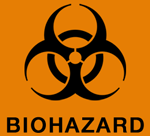The test results came back and were negative for both HBV, HCV and HIV, but she would need to continue with her PEP and repeat testing. Never, before was Jennifer so grateful that her hospital followed the OSHA Standard so carefully and that they knew exactly what to do to help her after a needle stick. They would even pay for her treatment and follow-up.
Information and Training
All new employees or employees being transferred into jobs involving tasks or activities with potential exposure to blood or OPIM are required to receive training prior to an assignment to tasks where occupational exposure may occur. Training typically includes information on the hazards associated with blood and OPIM, the protective measures to be taken to minimize the risk of occupational exposure, and information on the appropriate actions to take if an exposure occurs.
Retraining is required annually, or when changes in procedures or tasks affecting occupational exposure occur. Employees must be provided access to a qualified trainer during the training session to ask and have answered questions as they arise.
OSHA’s Bloodborne Pathogens Standard specifies the content which must be addressed in annual re-training, appropriate in content and vocabulary to educational level, literacy, and language of employees. Employees should request work-place-specific information from their employers if it has not already been provided.
Annual training must address (and is included in this CE course):
- An accessible copy of the regulatory text of this standard and an explanation of its contents
- A general explanation of the epidemiology and symptoms of bloodborne diseases
- An explanation of the modes of transmission of bloodborne pathogens
- An explanation of the employer's ECP and the means by which the employee can obtain a copy of the written plan
- An explanation of the appropriate methods for recognizing tasks and other activities that may involve exposure to blood and OPIM
- An explanation of the use and limitations of methods that will prevent or reduce exposure including appropriate engineering controls, work practices, and PPE
- Information on the types, proper use, location, removal, handling, decontamination and disposal of PPE
- An explanation of the basis for selection of PPE
- Information on the hepatitis B vaccine, including information on its efficacy, safety, method of administration, the benefits of being vaccinated, and that the vaccine and vaccination will be offered free of charge
- Information on the appropriate actions to take and people to contact in an emergency involving blood or OPIM
- An explanation of the procedure to follow if an exposure incident occurs, including the method of reporting the incident and the medical followup that will be made available
- Information on the post exposure evaluation and follow-up that the employer is required to provide for the employee following an exposure incident
- An explanation of the signs and labels and/or color coding required
- An opportunity for interactive questions and answers with the person conducting the training session, who must be knowledgeable in the subject matter covered
Hazard Signs and Labels
The OSHA Standard requires warning labels be affixed to containers of regulated waste, refrigerators and freezers, and other containers used to store or transport blood or OPIM. The labels must use the word BIOHAZARD and be fluorescent orange or orange-red, and affixed in a manner that prevents their loss. Red bags or red containers may be substituted for labels.

Note that the biohazard sign is a good reminder that bloodborne pathogens may be present. However, bloodborne pathogens may also be present in many areas that do not have biohazard signs, both within healthcare facilities and in the general public. For this reason, it makes sense to minimize contact with body fluids and to protect any breaks in the skin, including mouth and eyes, at all times.
Test Your Knowledge
The Bloodborne Pathogens Standard requires annual retraining of workers and must:
- Cover problems currently being addressed in the workplace.
- Cover specific content required by OSHA.
- Be provided both in-house and on mobile devices.
- Be documented with a written test.
Apply Your Knowledge
How has your attitude changed about receiving and completing your employer’s annual required OSHA training? Did you realize it was their legal responsibility? How will your attitude improve the next time you have to complete the training?
Answer: B
